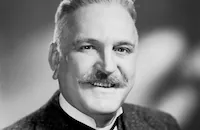Keeping Company

Brief Synopsis
Cast & Crew
S. Sylvan Simon
Frank Morgan
Ann Rutherford
John Shelton
Irene Rich
Gene Lockhart
Film Details
Technical Specs

Synopsis
Harry C. Thomas and his wife Susan head a brood of daughters-- Mary, who has just attained marriagable age; Harriet, a mischevous adolescent who spies on her sister and makes shrewd business deals for ice cream; and Evelyn, the middle sister. Mary's engagement to car salesman Ted Foster changes the status of the family, prompting Mr. and Mrs. Thomas to give the prospective newlyweds advice on marriage. Although both Ted and Mary insist that their marriage will be one without problems, misunderstandings arise with the appearance of Anastasia Atherton, Ted's old sweetheart who has just returned from New York. Because Anastasia is in need of money, Ted agrees to buy her car, but neglects to inform Mary of the transaction. Consequently, when Mary finds Anastasia's compact in the back seat of the car and discovers checks written from Ted to Anastasia, she assumes that Ted is being unfaithful and leaves her husband to return to the security of the Thomas home. Ted's worries are compounded when he convinces his boss, Mr. Hellman, to order forty new cars because a factory is scheduled to open in a nearby town, only to learn that the factory is not opening, thus placing Hellman in danger of bankruptcy. Plagued by problems, Ted disappears, leaving Mary behind to attend the annual Hellman picnic by herself. When Mr. Hellman, who has promised to make Ted his successor, fails to announce his intentions at the picnic, Mary chastises him for overlooking Ted's fine qualities. Soon afterward, Ted appears and announces that he has saved the agency by selling cars to a dealership in the town of Lyndhurst. When Hellman then tells Ted how Mary stood up for him, the newlyweds are reconciled.

Director

S. Sylvan Simon
Cast

Frank Morgan

Ann Rutherford
John Shelton

Irene Rich

Gene Lockhart

Virginia Weidler

Virginia Grey

Dan Dailey Jr.

Gloria De Haven

Sara Haden
Bert Roach

Ann Todd
Sally Martin

Fern Emmett
Harry Tyler

Cy Kendall

Joe Yule
Robert Winkler
Richard Crane
John Webb Dillon
Buddy Messinger
Crew
Daniele Amfitheatrof
Karl Freund
Cedric Gibbons
James H. Hill
Herman J. Mankiewicz
Samuel Marx
Wade B. Rubottom
Harry Ruskin
Adrian Scott
Douglas Shearer
Elmo Vernon
Edwin B. Willis
Dolph Zimmer

Film Details
Technical Specs

Articles
Keeping Company
By Violet LeVoit

Keeping Company
Virginia Grey (1917-2004)
She was was born in Los Angeles on March 22, 1917, and was exposed to the film industry at a very young age. Her father, Ray Grey, was a Keystone Cop and acted in several other of Mack Sennett's comedies with the likes of Mabel Normand, Dorothy Gish and Ben Turpin. When her father died when she was still a child, Virginia's mother encouraged her to join the acting game and audition for the role of Eva for Uncle Tom's Cabin, a big budget picture for Universal Studios in the day. She won the role, and acted in a few more pictures at the studio: The Michigan Kid and Heart to Heart (both 1928), before she decided to temporarily leave acting to finish her schooling.
She returned to films after graduating from high school, and after bouncing around Hollywood doing bits for various studios, she hooked up with MGM in 1938. Her roles in her first few films were fairly non-descript: In Test Pilot and Ladies in Distress (both 1938), she did little more than look pretty, but in the following year she had scene-stealing parts in The Women (upstaging Joan Crawford in a delicious scene as a wisecracking perfume counter girl) and as the suffering heroine in Another Thin Man (both 1939).
Despite her versatility (she could handle comedy or drama with equal effectiveness), MGM would cast her in some above-average, but hardly starmaking movies: Whistling in the Dark, The Big Store (both 1941), and Tarzan's New York Adventure (1942). She left MGM in 1943 and became a freelance actress for several studios, but her material as a leading lady throughout the '40s were mediocre: Swamp Fire, House of Horrors (both 1946), and Mexican Hayride (1948) were sadly the more interesting films in her post-MGM period. But by the '50s she was a well-established character actress, appearing in fairly big-budget pictures: All That Heaven Allows, The Rose Tattoo (both 1955), Jeanne Eagels (1957).
In the '60s, Grey turned to television and found work on a variety of hit shows: Wagon Train, Peter Gunn, Bonanza, My Three Sons, I Spy, and several others; plus she also captured a a couple of notable supporting parts in these films: Madame X (1966), and Airport (1970), before retiring completely from acting in the early '70s. She is survived by her sister, Lorraine Grey Heindorf, two nieces and two nephews.
by Michael T. Toole
Virginia Grey (1917-2004)
Quotes
Trivia
Notes
This picture was to be the first in a series of M-G-M features detailing the homey adventures of the Thomas family. No other films featuring these characters was ever made, however.















